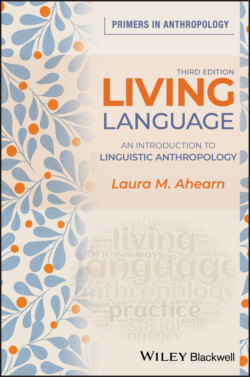Читать книгу Living Language - Laura M. Ahearn - Страница 12
Acknowledgments
ОглавлениеI have continued to incur debts during the preparation of this third edition and am grateful to have the opportunity to thank at least some of the individuals who helped me during the revision process. First, my wonderful colleagues on the LEARN contract provided many useful and amusing examples of language use, only some of which, such as Eva Schiffer’s “Backpfeifengesicht,” I was able to include in this edition. But all my fellow LEARNers provided encouragement, support, and an intellectually stimulating environment that surpassed anything I have experienced elsewhere. I am also grateful to my former academic colleagues, including Steven Black, Liz Coville, Janina Fenigsen, Lisa Gezon, Debby Keller-Cohen, Jan David Hauck, Tom Kias, Karen Pennesi, Beatriz Reyes-Foster, Rachel Reynolds, Jonathan Rosa, Becky Schulthies, and Mark Sicoli. In addition, I enjoyed very much working with the members of the editorial board for my Oxford Studies in the Anthropology of Language series; Sandro Duranti, Paul Garrett, and Justin Richland provided me with an incredible amount of intellectual growth (and fun) during the years we worked together, and I am very proud of the books we chose to publish in the series, a number of which have won awards. I would also like to thank Tingting Gao for giving numerous guest lectures on ASL in my classes over the years and for being the source of a great deal of information and inspiration. And finally, I am very grateful to Grzegorz Godlewski in Warsaw for facilitating the publication of a Polish edition of Living Language, and to Kerim Friedman in Taiwan for laying the groundwork for a Chinese translation of the book.
This book was many years in the making, and I could never adequately thank everyone to whom I am indebted in various ways for helping me write it. I owe so much to the scholars who most deeply influenced me during my graduate training: Tom Fricke, Bruce Mannheim, and Sherry Ortner. During and after my years in graduate school, I have continued to be inspired by the work of Alessandro Duranti, Susan Gal, Marjorie Harness Goodwin, Jane Hill, Judy Irvine, Paul Kroskrity, Elinor Ochs, Bambi Schieffelin, and Jim Wilce. I was also fortunate to be situated for many years within a cultural anthropology program at Rutgers, Critical Interventions in Theory and Ethnography, that took seriously the need to integrate a close analysis of language into any study of social or cultural practices. My colleagues at Rutgers, especially Parvis Ghassem-Fachandi, Daniel Goldstein, Angelique Haugerud, Dorothy Hodgson, David Hughes, and Becky Schulthies, were all extremely supportive of this project. Other colleagues, including Janina Fenigsen, Bridget Hayden (who also caught my initial misspelling of “purl” in the knitting analogy), Kathy Hunt, Dillon Mahoney, Ryne Palombit, Gary Rendsburg, Heidi Swank, Suzanne Wertheim, Jim Wilce, and John Zimmerman, have also read and commented on some or all of these chapters, or have even “test driven” them in their own linguistic anthropology classes, and for all their feedback I am enormously grateful. Jim Wilce, in particular, has been a most consistently encouraging and patient supporter throughout this long process, and his belief in this book helped me move forward at several critical periods when I was unsure of how to proceed.
My students have also provided me with inspiration and concrete advice on how to improve the book. Students in my undergraduate linguistic anthropology classes, including Liane Alves, Chris Correa, Tingting Gao, Mickey Hennessey, Christina Le, Eugene Leytin, Erika Varga, and Alysis Vasquez, were amazingly patient with me as I turned them into guinea pigs in this process; they offered extremely perceptive comments on how to make the book more accessible to college students. My brilliant graduate students were equally generous with their advice. I am particularly grateful to all the students who took my Language as Social Action and Theories of Agency seminars over the years, especially Chelsea Booth, Assaf Harel, Meghana Joshi, Noelle Molé, and Kartikeya Saboo, for pushing me to think in new ways about the material presented in this book.
I am also thankful to Jane Huber, the editor at Wiley-Blackwell who got me interested in this project. Eric Richardson wisely urged a more user-friendly title, and Ayala Fader and Liliana Sanchez offered helpful feedback. Peter Laipson, my loyal critic, read the first four chapters of this book and dictated copious comments for me using Dragon Naturally Speaking, thereby providing an excellent demonstration of the limitations of the early versions of speech recognition software (but also of course improving my eloquence quotient enormously for those chapters). The anonymous readers of the book proposal for the third edition buoyed me with their wonderful comments and feedback, and the five anonymous reviewers of the entire manuscript humbled me with their close readings and wise advice. I only wish I had had the time and intellectual capacity to implement more of their suggestions.
Finally, I am indebted beyond words to my family. My parents, Eileen and Fred Ahearn, have always encouraged me with loving support and intellectual stimulation. My sisters, Peggy Schroeder and Kerry Ahearn, remain my dearest friends. My husband (also known as my in-house editor and favorite correspondent), Rick Black, has offered me more guidance, inspiration, and constant encouragement than I could ever enumerate or reciprocate. I am so, so lucky to have him as my “life friend.”
And to my daughter, Melanie Anne Ahearn Black, I dedicate this book, which has been in the making in one form or another for the entire sixteen years of her life. From helping with the Japanese example in Chapter 8 to providing valuable data on teen linguistic practices, Mellie has been extremely helpful in the revisions for this third edition. So much of what has come to fascinate me about language and what I have come to value in life can be traced to her.
Laura M. Ahearn
